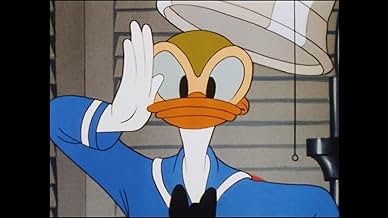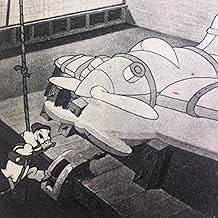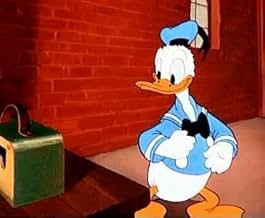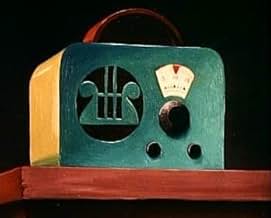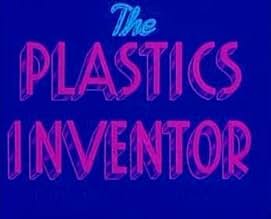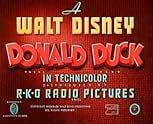Donald listens to a radio program that tells him how to make a fully-working airplane completely out of plastic.Donald listens to a radio program that tells him how to make a fully-working airplane completely out of plastic.Donald listens to a radio program that tells him how to make a fully-working airplane completely out of plastic.
- Director
- Writers
- Stars
John Dehner
- Radio Voice
- (uncredited)
Clarence Nash
- Donald Duck
- (uncredited)
Charles Seel
- Professor Butterfield
- (uncredited)
- Director
- Writers
- All cast & crew
- Production, box office & more at IMDbPro
Featured reviews
Here's another interesting Donald Duck cartoon where he listens to a radio program that tells him how to make an airplane completely out of plastic, including bolts, screws, propellers and wings. This seems very fantastic and out of this world; course this won't work in real life, but this is Disney magic.
Plenty of misadventures with Donald and his plastic plane, along with plenty of slapstick humor and classic Donald personality. The animation was also great.
This cartoon was somewhat funny, not the best I've seen, but still somewhat entertaining and good for the entire family.
Grade B-
Plenty of misadventures with Donald and his plastic plane, along with plenty of slapstick humor and classic Donald personality. The animation was also great.
This cartoon was somewhat funny, not the best I've seen, but still somewhat entertaining and good for the entire family.
Grade B-
A Walt Disney DONALD DUCK Cartoon.
Donald puts together an airplane made entirely out of plastic. Now he's ready for the test flight...
THE PLASTICS INVENTOR is a very enjoyable little film, with good sight gags & a funny plot which is perfect for the frenetic Duck. The Plastic Hour, with the soothing murmur of Professor Butterfield giving outrageous instructions, is a hilarious spoof of radio cooking programs of the era. Clarence Nash provides Donald's unique voice.
Walt Disney (1901-1966) was always intrigued by pictures & drawings. As a lad in Marceline, Missouri, he sketched farm animals on scraps of paper; later, as an ambulance driver in France during the First World War, he drew comic figures on the sides of his vehicle. Back in Kansas City, along with artist Ub Iwerks, Walt developed a primitive animation studio that provided animated commercials and tiny cartoons for the local movie theaters. Always the innovator, his ALICE IN CARTOONLAND series broke ground in placing a live figure in a cartoon universe. Business reversals sent Disney & Iwerks to Hollywood in 1923, where Walt's older brother Roy became his lifelong business manager & counselor. When a mildly successful series with Oswald The Lucky Rabbit was snatched away by the distributor, the character of Mickey Mouse sprung into Walt's imagination, ensuring Disney's immortality. The happy arrival of sound technology made Mickey's screen debut, STEAMBOAT WILLIE (1928), a tremendous audience success with its use of synchronized music. The SILLY SYMPHONIES soon appeared, and Walt's growing crew of marvelously talented animators were quickly conquering new territory with full color, illusions of depth and radical advancements in personality development, an arena in which Walt's genius was unbeatable. Mickey's feisty, naughty behavior had captured millions of fans, but he was soon to be joined by other animated companions: temperamental Donald Duck, intellectually-challenged Goofy and energetic Pluto. All this was in preparation for Walt's grandest dream - feature length animated films. Against a blizzard of doomsayers, Walt persevered and over the next decades delighted children of all ages with the adventures of Snow White, Pinocchio, Dumbo, Bambi & Peter Pan. Walt never forgot that his fortunes were all started by a mouse, or that childlike simplicity of message and lots of hard work will always pay off.
Donald puts together an airplane made entirely out of plastic. Now he's ready for the test flight...
THE PLASTICS INVENTOR is a very enjoyable little film, with good sight gags & a funny plot which is perfect for the frenetic Duck. The Plastic Hour, with the soothing murmur of Professor Butterfield giving outrageous instructions, is a hilarious spoof of radio cooking programs of the era. Clarence Nash provides Donald's unique voice.
Walt Disney (1901-1966) was always intrigued by pictures & drawings. As a lad in Marceline, Missouri, he sketched farm animals on scraps of paper; later, as an ambulance driver in France during the First World War, he drew comic figures on the sides of his vehicle. Back in Kansas City, along with artist Ub Iwerks, Walt developed a primitive animation studio that provided animated commercials and tiny cartoons for the local movie theaters. Always the innovator, his ALICE IN CARTOONLAND series broke ground in placing a live figure in a cartoon universe. Business reversals sent Disney & Iwerks to Hollywood in 1923, where Walt's older brother Roy became his lifelong business manager & counselor. When a mildly successful series with Oswald The Lucky Rabbit was snatched away by the distributor, the character of Mickey Mouse sprung into Walt's imagination, ensuring Disney's immortality. The happy arrival of sound technology made Mickey's screen debut, STEAMBOAT WILLIE (1928), a tremendous audience success with its use of synchronized music. The SILLY SYMPHONIES soon appeared, and Walt's growing crew of marvelously talented animators were quickly conquering new territory with full color, illusions of depth and radical advancements in personality development, an arena in which Walt's genius was unbeatable. Mickey's feisty, naughty behavior had captured millions of fans, but he was soon to be joined by other animated companions: temperamental Donald Duck, intellectually-challenged Goofy and energetic Pluto. All this was in preparation for Walt's grandest dream - feature length animated films. Against a blizzard of doomsayers, Walt persevered and over the next decades delighted children of all ages with the adventures of Snow White, Pinocchio, Dumbo, Bambi & Peter Pan. Walt never forgot that his fortunes were all started by a mouse, or that childlike simplicity of message and lots of hard work will always pay off.
The basic concept, with the radio giving instructions on how to do something, is not exactly new from Disney, but when the short in question takes this concept in a fresh and imaginative way this doesn't matter in the slightest. That is exactly the case with The Plastics Inventor. The animation as ever is beautifully done, the colours are luscious and very 1940s Disney(which is a great thing, as some of their best work came from this era) and the backgrounds are attentive to detail and does so with fluidity. The music is similarly wonderful, it is orchestrated in a way that gels perfectly with the action and it has a lot of character also. The story is simple, but charming and a lot of fun. In terms of the gags and humour, it is all very clever and inventive. It starts off very funny and gets even better once the plane is in the air. The lengths Donald goes through to keep things going without putting himself in mortal jeopardy makes for great comedy. The story works perfectly for Donald, and he is very funny as well as easily identifiable. All in all, enormously entertaining and imaginative, one of Donald's best and funniest of the early 40s. 10/10 Bethany Cox
This short is clever and very funny, as it follows Donald through the process of building and flying a plane he makes entirely from plastic! I ask you, how secure would you feel riding in a plane made of plastic constructed and piloted by a very impatient and short-tempered duck. Parachutes, anyone? Sadly, this is not in print. It does occasionally air on The Ink and Paint Club and is well worth tracking down. Recommended.
Donald is quite the inventor. He is addicted to a radio show that tells him how to make things out of plastic. In this case, he decides to make an airplane. He has accumulated all this junk and melts it and pours it into a mold. Then he builds a plastic engine. However, even though the thing is amazing, the commentator forgets to tell Donald an important thing. All that aside, this is an action packed cartoon with our boy really showing skill. It is colorful and interesting. I wonder where the development of plastic was around 1944 (during serious wartime).
Did you know
- ConnectionsEdited into Get It Right: Following Directions with Goofy (1982)
Details
- Release date
- Country of origin
- Language
- Also known as
- The Plastics Inventor
- Production company
- See more company credits at IMDbPro
- Runtime7 minutes
- Aspect ratio
- 1.37 : 1
Contribute to this page
Suggest an edit or add missing content



